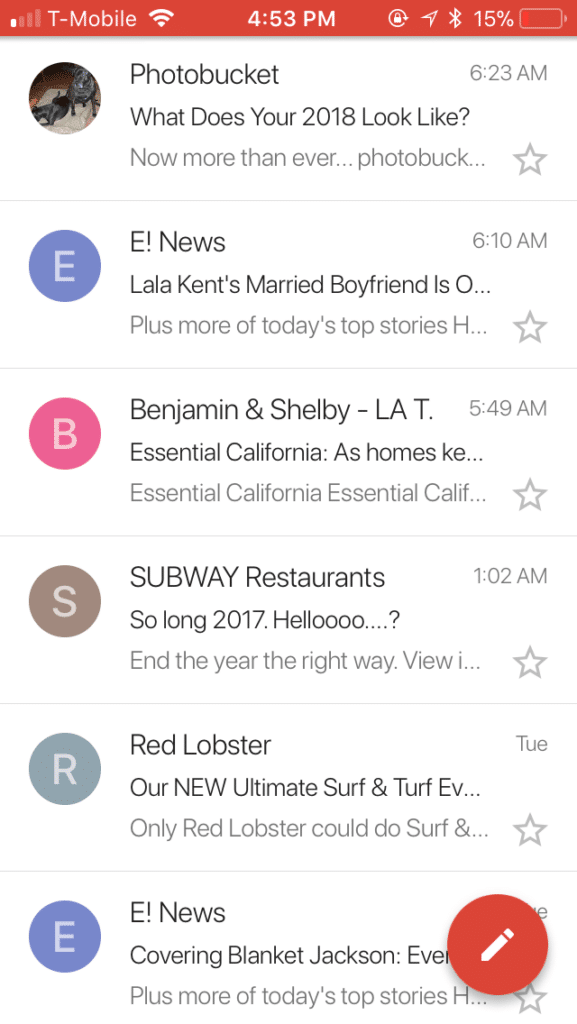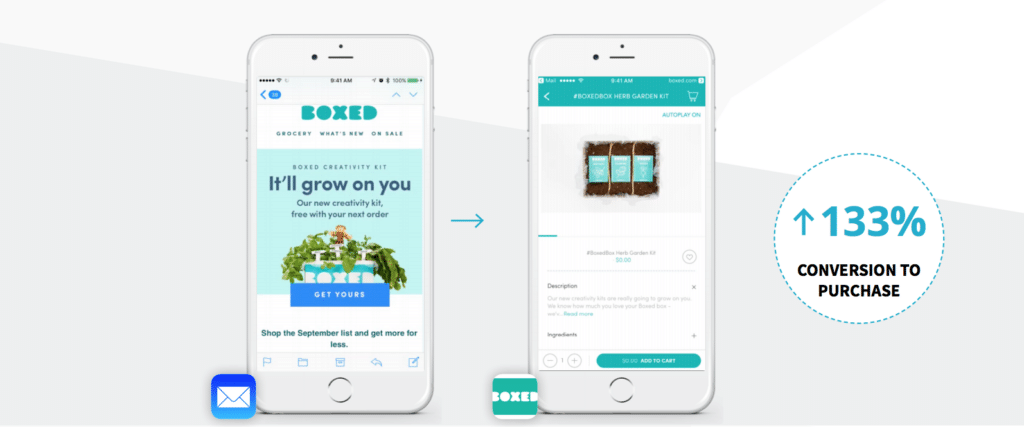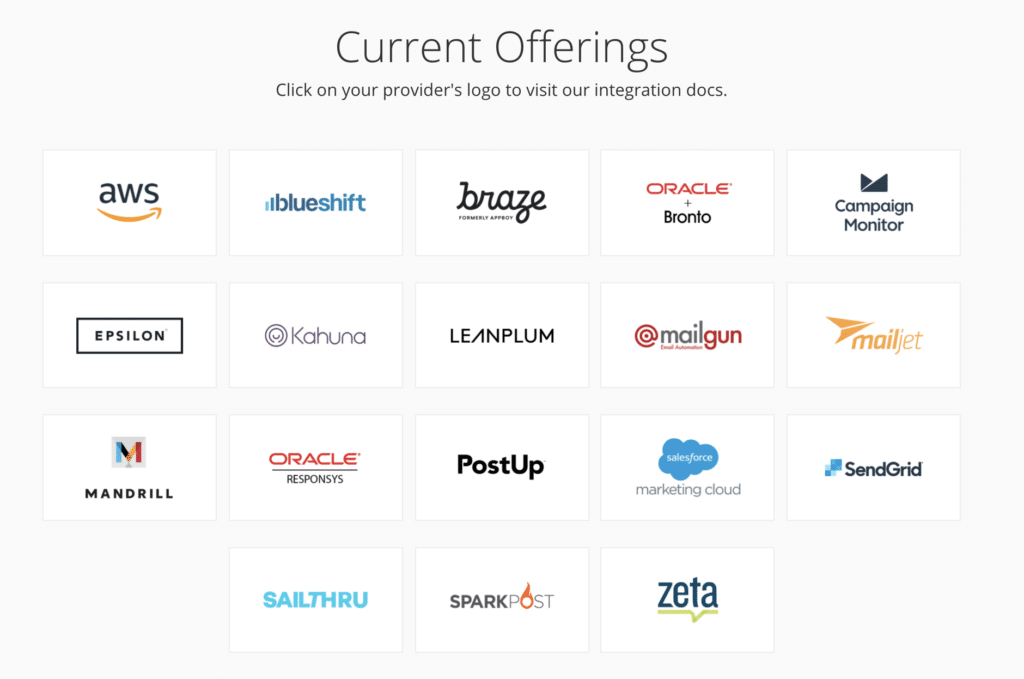For over a decade, email marketing has proved the highest-performing marketing channel in terms of return on investment. In fact, marketing through email achieves $44 in ROI for every $1 spent. In order to achieve these spectacular results, the best email marketers make sure to always send highly-relevant emails to their hard-earned subscribers. However, a major challenge to email marketers everywhere is keeping up with the constantly-changing eCommerce landscape. Over 70% of emails are now opened on mobile rather than desktop (up from 20% in 2011). According to TechCrunch, total online purchases on mobile surpassed desktop for the first time in history last holiday season.
This guide is full of email marketing solutions, strategies, and tools for small business and enterprise marketers alike. We’ll walk through the best enhancements and metrics to reference when creating marketing emails that your subscribers will love. First, we’ll review the challenges associated with mobile marketing in 2018, and then we’ll discuss ways of optimizing email marketing campaigns on mobile — such as creating simple and quick deep links that lead subscribers directly from emails to in-app content.
The Mobile Challenge
Most email marketing professionals benchmark every campaign against certain criteria: deliverability rate, open rate, click through rate, and the conversion rate.
Each represents a different milestone in an email campaign. However, the mobile environment is more dense, and users’ attention spans are shorter. Cross-platform promotional campaigns will need to be seamlessly optimized in this dynamic ecosystem, or else you’ll risk losing opportunities on simple snags along the subscriber journey.
Quick Note on Deliverability Maintenance
Deliverability maintenance is the most important upkeep task for an email marketer. This responsibility ensures that promotional emails don’t bounce or register as spam. Many ESPs record bounced email addresses and take them off subscriber lists. Too many bounced emails will cause your organization’s sender reputability to go down, and your emails will be channeled into spam boxes. Additionally, sender reputability is negatively impacted by the integration of purchased email lists into marketing email recipient lists, as users who receive purely promotional emails without subscribing will usually mark them as spam. According to Marketo, ISPs love engagement, so sending emails to the right people—at the right time, and with the right frequency—will set your campaigns up for success. In summary, spammers get blocked by ISPs, but email marketers with clean subscriber lists will remain in their good graces.
Open Rate
Open rate is an essential metric for any email marketing professional, and is defined as the “(number of emails opened / number of emails delivered ) * 100.”
For example, if a marketer sends 1 million emails and 200,000 are opened, the open rate is 20%. The open rate is an important step in an email campaign because it’s the first major bottleneck where subscribers drop off. The majority of emails sent are unread or deleted before they are opened. In order to improve (and thereby maximize) open rates, email marketers should optimize subject lines and preview text.
The subject line is the first element of your email that subscribers will see in their inboxes. You will want to craft a captivating and concise message in order to encourage subscribers to read your emails. Otherwise, your valued subscribers will send the message you labored over to the trash bin.
A distinction between desktop and mobile is the number of characters that the screen can display. Many desktop inboxes display up to 80 characters, whereas the mobile versions show no more than 30 characters. Any subject line more than 30 characters will be cut off. Keep your messages simple and straightforward—get to the point, and you’ll get opens.
Preview text is often misunderstood—it’s an email marketer’s last chance to encourage subscribers to check out message content. Readers who read a subject line and are on the cusp of opening will often defer to the pre-header text. It’s a valuable area to explain the “why” of your email to your subscribers.
According to Litmus, a testing and QA provider for email marketers, the following devices will display a limited number of characters in their preview text:
| Device Name and Email Provider | Number of Characters Displayed |
| iOS Native Email App | 50 |
| iOS Gmail App | 50 |
| iOS Yahoo App | 50 |
| Android Native Email App | 40 |
| Android Gmail App | Varies based on length of preview text |
| Android Yahoo App | 45 |
| Windows Mobile | 40 |
Click Through Rate
The click through rate is defined as “(number of unique clicks / number of emails delivered) * 100.” For example, if a campaign delivers over 100,000 unique clicks for every 1 million emails delivered, that campaign will have a click through rate of 10%.
In order to encourage subscribers who open your email to take the next step and click, you’ll need to create compelling content. According to the Nielsen Group, “time allocated to a newsletter after opening [is] only 51 seconds.” In other words, marketers have less than a minute to capture their subscribers’ attention.
Striking the right balance between image and text is a sure-fire way to capture your subscribers’ attention and stand out in their inboxes. Emails that have too much text drown mobile viewers in verbiage. Web user eye-tracking data has found that viewer concentration plummets to “20% of their attention [scrolling] below the fold.” In mobile email, there is no need to meander—save that copy for your content articles. Furthermore, it’s critical to remember that a picture is worth a thousand words. Use powerful imagery to drive your marketing message in mobile—this will keep your readers focused, and your content compelling.
Lastly, the visualization of an email’s call to action should be easily accessible in the form of a mobile-friendly button. According to MIT researchers, the average size of an adult pointer finger is between 0.62 to 0.78 inches—this correlates to between 45 x 45px and 57 x 57px on a mobile device. Marketers who want to lead their subscribers to the next stage of a campaign’s funnel are doing themselves a disservice when their buttons are too small to be effective. In short, keeping clickable targets larger makes clicking easier for subscribers who are interested.
Conversion Rate
The conversion rate is defined as “(the number of users who have completed a desired action / emails delivered) * 100.” For example, an email marketer who sends 100,000 emails with 6,000 users performing a desired action has a conversion rate of 6%.
This is the final leg of the buyer’s journey, and encapsulates a critical transition from the inbox to the app. Email marketers craft perfect headlines, preview text, and email bodies all leading up to delivering users to a convenient purchasing point.
On mobile, the optimal email marketing strategy leads users from email into an app. In fact, app users spend 18 times more than mobile web users, so it’s no secret that marketing teams looking to increase revenue will want to send users to the app instead of the mobile web.
For this reason, today’s best email marketers are creating fluid and seamless user journeys from their subscribers’ inboxes into their apps. Otherwise, they risk missing out on valuable revenue. The Relevancy Group discovered that email marketers’ number one problem is actually creating “email links to the mobile app (deep linking).”
Deep Linked Emails
With the majority of commerce conducted over mobile, apps now have a more prominent role in how and when consumers buy. Unfortunately, the infrastructure on mobile is fragmented, and it normally takes heavy dev resources to ensure that a single promotional link routes various users (iOS, Android, etc.) to the right content within an app. In absence of standardization, Branch has a developed a deep linking infrastructure that allows our partners to easily generate deep links on demand. One application is deep linked emails which are emails that can route mobile users directly to relevant in-app content, through our Universal Email offering.
Branch has worked with several partners and estimates that for every 1 million emails sent without deep linking into your mobile app, you are losing thousands of dollars in top line revenue. These easy mobile fixes can have massive returns if executed well and done right. In fact, we helped Instacart create seamless email-to-app mobile experiences, and multiplied its email click-to-purchase rate by six in the process. Similarly, Boxed saw its click-to-purchase rate surge by 133% after routing users from marketing emails into their app with Branch links.
Branch has built out integrations with the majority of major email service providers in order to provide seamless deep linking to our partners:
A study released by Deloitte found that Americans collectively check their smartphones upwards of 8 billion times per day. How many of your promotional links are sending users to the right place? To ensure your marketing team isn’t missing out on this massive opportunity to re-engage with subscribers and increase revenue, request a demo to see how you can get deep linking in your marketing emails today.


























